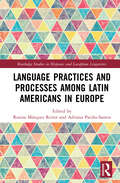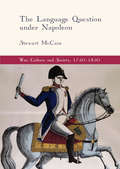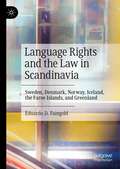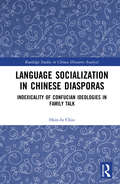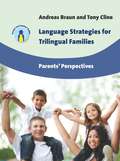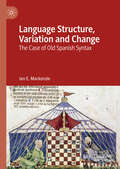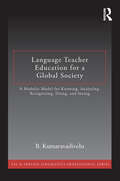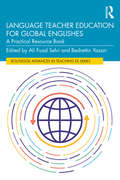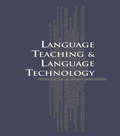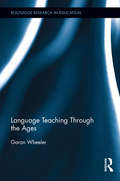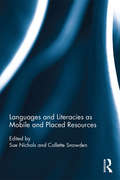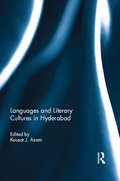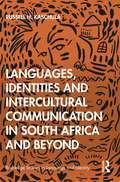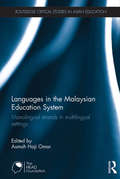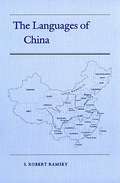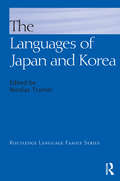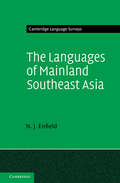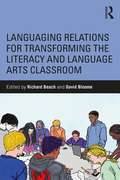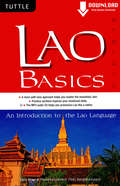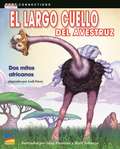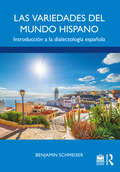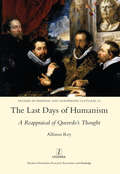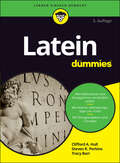- Table View
- List View
Language Practices Among Children and Youth in Indonesia
by Bernadette Kushartanti Dwi Noverini DjenarThis open access book presents studies of language use in Indonesia, focusing on children and youth. It reports on developments in the use of language for narrative production and within the realm of popular culture and traditional cultural practices in Indonesia. Through studies that include cohesion in narrative production, language in radio advertising, naming practices and formulaic prohibitions in Javanese, and speech presentation in popular fiction, the book provides insights into how sociocultural changes are reflected in language. This book is a useful resource for students and scholars conducting research on language and cultural practices in Indonesia, particularly in relation to children and young people.
Language Practices and Processes among Latin Americans in Europe (Routledge Studies in Hispanic and Lusophone Linguistics)
by Rosina Márquez Reiter and Adriana Patiño-SantosLanguage Practices and Processes among Latin Americans in Europe is an innovative and thematically organised collection of studies dedicated to contemporary sociolinguistic research on Latin Americans across European contexts. This book captures some of the language practices and experiences of Spanish-speaking Latin Americans (SsLAs) across various regions in Europe, addressing language uses, language ideologies, and experiences with languages in particular geographical contexts and settings across the ten chapters. The book provides a new lens to study the sociolinguistics of the migratory trajectories of Spanish-speaking Latin American migrants and the situated practices and processes in which they participate in their host societies. The comprehensive volume will be of interest to researchers in the area of Spanish sociolinguistics, sociology of language, and language ideology.
The Language Question under Napoleon
by Stewart McCainThis book offers a new perspective on the cultural politics of the Napoleonic Empire by exploring the issue of language within four pivotal institutions - the school, the army, the courtroom and the church. Based on wide-ranging research in archival and published sources, Stewart McCain demonstrates that the Napoleonic State was in reality fractured by disagreements over how best to govern a population characterized by enormous linguistic diversity. Napoleonic officials were not simply cultural imperialists; many acted as culture-brokers, emphasizing their familiarity with the local language to secure employment with the state, and pointing to linguistic and cultural particularism to justify departures from which what others might have considered desirable practice by the regime. This book will be of interest to scholars of the Napoleonic Empire, and of European state-building and nationalisms.
Language Rights and the Law in Scandinavia: Sweden, Denmark, Norway, Iceland, the Faroe Islands, and Greenland
by Eduardo D. FaingoldThis book examines the language policies in the constitutions, legal statutes, and regulations of Sweden, Denmark, Norway, Iceland, the Faroe Islands, and Greenland. In these countries and territories, modern descendants of Old Norse (North Germanic) are spoken today: Swedish, Danish, Norwegian, Icelandic, and Faroese. In addition, there are regions of Scandinavia where speakers of minority languages were conquered or incorporated, with their languages suppressed or neglected, as well as recent developments in the status and use of English, and immigrant populations who do not speak a Scandinavian language as their native language. This book adopts a comparative approach to trace the development of language policies and rights in Scandinavia, and it will be of interest to students as well as scholars of European and Scandinavian studies, applied linguistics, sociolinguistics, education, political science, and law.
Language Socialization in Chinese Diasporas: Indexicality of Confucian Ideologies in Family Talk (Routledge Studies in Chinese Discourse Analysis)
by Hsin-fu ChiuThe monograph provides ethnographically informed analyses of indigenous kin interactions in three Chinese diasporic households in the county of Los Angeles, California, U.S.A. Drawing upon the approach that regards talk as a form of social practice, the book demonstrates different ways in which kin relationships are indigenously orchestrated by foreign Chinese parents and their American-born children. Micro-analytically, social actions of membership categorization, attribution, deference, compliance, commands, and story-telling that unfold in kin interactions are foregrounded as key language devices to discuss ways in which epistemic asymmetry, power hierarchy, and harmony in kin relations are constructed or deconstructed in Chinese diasporic social lives. By way of illustration, the monograph, macro-analytically, speaks to the cultural stereotype of Chinese immigrant/foreign parents’ style of parenting when they pass on the traditional Confucian ideologies in kin interaction. This book can be a useful reference textbook for graduate courses that address the dynamic intricacy among language, culture, and society.
Language Strategies for Trilingual Families
by Andreas Braun Tony ClineThis book aims to enable parents in trilingual families to consider possible language strategies on the basis of analysing their individual circumstances. It includes a tool for diagnostic self-analysis that will help each reader to identify their situation and learn how parents in similar situations have approached the task of supporting their children's use of languages. Based on a unique survey of parents in trilingual families in two European countries, the book highlights the challenges that trilingual families face when living in mainly monolingual societies. It takes into account the recent emergence of a 'New Trilingualism' among educated parents who find themselves in trilingual families because of global trends in migration and the recent expansion of the EU.
Language Structure, Variation and Change: The Case of Old Spanish Syntax
by Ian E. MackenzieThis book offers an original account of the dynamics of syntactic change and the evolving structure of Old Spanish that combines rigorous manuscript-based investigation, quantitative analysis and a syntactic approach grounded in Minimalist thinking. Its analysis of both successful and failed changes demonstrates the degree of unpredictability caused by the interaction of competing factors and will shed fresh light on the assumed unidirectionality of linguistic change. Importantly, it reveals that Old Spanish and modern Spanish are more similar to one another than is usually supposed and demonstrates that many of the differences between the two varieties are quantitative rather than qualitative. This theoretically sophisticated examination of historical corpora will provide an invaluable resource for students and scholars of Old and modern Spanish, historical linguistics, sociolinguistics and syntax.
Language Teacher Education for a Global Society: A Modular Model for Knowing, Analyzing, Recognizing, Doing, and Seeing (ESL & Applied Linguistics Professional Series)
by B. KumaravadiveluThe field of second/foreign language teacher education is calling out for a coherent and comprehensive framework for teacher preparation in these times of accelerating economic, cultural, and educational globalization. Responding to this call, this book introduces a state-of-the-art model for developing prospective and practicing teachers into strategic thinkers, exploratory researchers, and transformative teachers. The model includes five modules: Knowing, Analyzing, Recognizing, Doing, and Seeing (KARDS). Its goal is to help teachers understand: how to build a viable professional, personal and procedural knowledge-base, how to analyze learner needs, motivation and autonomy, how to recognize their own identities, beliefs and values, how to do teaching, theorizing and dialogizing, and how to see their own teaching acts from learner, teacher, and observer perspectives. Providing a scaffold for building a holistic understanding of what happens in the language classroom, this model eventually enables teachers to theorize what they practice and practice what they theorize. With its strong scholarly foundation and its supporting reflective tasks and exploratory projects, this book is immensely useful for students, practicing teachers, teacher educators, and educational researchers who are interested in exploring the complexity of language teacher education.
Language Teacher Education for Global Englishes: A Practical Resource Book (Routledge Advances in Teaching English as an International Language Series)
by Ali Fuad SelviThis practical resource book showcases both the theory and practical application for teacher educators in diverse contexts bringing a global Englishes perspective into their teacher education courses, both at pre- and in-service levels. The recent Global Englishes paradigm serves as a promising response to the complexity of identity, interaction, use, and instruction surrounding the English language. It is increasingly important to enhance teachers’ knowledge base—their specialized knowledge, skills, competencies, and commitments—vis-à-vis the changing needs of English Language Teaching. The chapters in the book provide accessible theoretical orientation to different aspects of the Global Englishes paradigm, from instructional materials to language assessment, and are complemented by a range of practical applications that promote teacher development. The volume is recommended as a viable professional development resource for teacher educators who are looking for activities and resources in preparing teachers for diverse teaching contexts, realities, affordances, and constraints.
Language Teaching and Language Technology
by John Nerbonne Sake Jager Arthur Van EssenThis text assesses the importance of language technology to increasingly popular computer-assisted language learning work. The book contains writings on pronunciation, vocabulary, grammar, reading, writing, testing, distance learning and user studies.
Language Teaching Through the Ages (Routledge Research in Education #93)
by Garon WheelerKonrad Koerner, a leading historian of linguistics, has long said that an academic field cannot be considered to have matured until it has history as one of its subfields. The history of linguistics is a growing area, having come into its own in the 1960s, especially after Noam Chomsky looked for historical roots for his work. In contrast, the history of language teaching has been neglected, reflecting the insecurity and youth of the field. Most works on the subject have been written by linguists for other linguists, and typically focus on a specific period or aspect of history. This volume concentrates on the basic issues, events, and threads of the history of the field - from Mesopotamia to the present - showing how a knowledge of this history can inform the practice of language teaching in the present.
Languages and Literacies as Mobile and Placed Resources
by Sue Nichols Collette SnowdenLanguages and Literacies as Mobile and Placed Resources explores how languages and literacies are implicated in the complex relationship between place and mobility. It is a book that represents the next wave in literacy studies in which theories of mobility, networking and globalisation have emerged to account for the dynamic landscape of globally circulating communication resources. Authors in this volume take up a more complex way of thinking about resources, applying it to consider languages and literacies as assemblages or as parts of assemblages that are involved in learning, teaching and meaning-making. The book addresses forms of text and mobility that arise in contexts outside of formal education including marketing, charity, journalism, community organisation and parenting. It also addresses school contexts and higher education settings. Key topics explored include: Consequences of workplace confinement Literacies as placed resources in the context of rural communities Literacy, sustainability and landscapes for learning Documenting networked knowledge on tablets Mobilising literacy policy through resources Global Englishes as placed resources Languages as contextualised resources Shaping a digital academic writing resource in a transcultural space With an international range of carefully chosen contributors, this book is a must read text for all academics interested in semiotics and literacy studies.
Languages and Literary Cultures in Hyderabad
by Kousar J. AzamThere is great interest in recent scholarship in the study of metropolitan cultures in India as evident from the number of books that have appeared on cities such as Delhi, Mumbai, Chennai and Kolkata. Though Hyderabad has a rich archive of history scattered in many languages, very few attempts have been made to bring this scholarship together. The papers in this volume bring together this scholarship at one place. They trace the contribution of different languages and literary cultures to the multicultural mosaic that is the city of Hyderabad How it has acquired this uniqueness and how it has been sustained is the subject matter of literary cultures in Hyderabad. This work attempts to trace some aspects of the history of major languages practiced in the city. It also reviews the contribution of the various linguistic groups that have added to the development not just of varied literary cultures, but also to the evolution of an inclusive Hyderabadi culture. The present volume, it is hoped, will enthuse both younger and senior scholars and students to take a fresh look at the study of languages and literary cultures as they have evolved in India's cities and add to the growing scholarship of metropolitan cultures in India.
Languages, Identities and Intercultural Communication in South Africa and Beyond (Routledge Studies in Language and Identity)
by Russell H KaschulaAfrican countries and South Africa in particular, being multilingual and multicultural societies, make for exciting sociolinguistic and applied language analysis in order to tease out the complex relationship between language and identity. This book applies sociolinguistic theory, as well as critical language awareness and translanguaging with its many facets, to various communicative scenarios, both on the continent and in South Africa, in an accessible and practical way. Africa lends itself to such sociolinguistic analysis concerning language, identity and intercultural communication. This book reflects consciously on the North–South debate and the need for us to create our own ways of interpretation emanating from the South and speaking back to the North, and on issues that pertain to the South, including southern Africa. Aspects such as language and power, language planning, policy and implementation, culture, prejudice, social interaction, translanguaging, intercultural communication, education, gender and autoethnography are covered. This is a valuable resource for students studying African sociolinguistics, language and identity, and applied language studies. Anyone interested in the relationship between language and society on the African continent would also find the book easily accessible.
Languages in the Malaysian Education System: Monolingual strands in multilingual settings (Routledge Critical Studies in Asian Education)
by Asmah Haji OmarThis book provides an overview of language education in Malaysia, covering topics such as the evolution of the education system from pre-independence days to the present time, to the typology of schools, and the public philosophy behind every policy made in the teaching of languages. The book consists of chapters devoted to the teaching of languages that form separate strands but are at the same time connected to each other within the education system. These chapters discuss: Implementing the national language policy in education institutions English in language education policies and planning in Malaysia Chinese and Tamil language education in Malaysia Teaching of indigenous Malaysian languages The role of translation in education in Malaysia It also discusses the development of language which enables the national language, Malay, to fulfil its role as the main medium of education up to the tertiary level. This book will be of interest to researchers studying language planning, teacher education and the sociology of education, particularly, within the Malaysian context.
The Languages of China
by S. Robert RamseyIn producing a book on China as a linguistic area, the ideal is a comprehensive and accurate account that places China's linguistic diversity in a meaningful historical, geographical, and social context. Ramsey has succeeded admirably in achieving this end. The Languages of China a pleasure in virtually all respects. It is extremely easy to read, full of useful information, and beautifully produced
The Languages of Japan and Korea (Routledge Language Family Ser.)
by Nicolas TranterThe Languages of Japan and Korea provides detailed descriptions of the major varieties of languages in the region, both modern and pre-modern, within a common format, producing a long-needed introductory reference source. Korean, Japanese, Ainu, and representative members of the three main groupings of the Ryukyuan chain are discussed for the first time in a single work. The volume is divided into language sketches, the majority of which are broken down into sections on phonology, orthography, morphology, syntax and lexicon. Specific emphasis is placed on those aspects of syntactic interest, such as speech levels, honorifics and classifiers, which are commonly underplayed in other descriptions of Modern Japanese and Korean. Each language is represented in Roman-based transcription, although its own script (where there is such an orthography) and IPA transcriptions are used sparingly where appropriate. The dialects of both the modern and oldest forms of the languages are given extensive treatment, with a primary focus on the differences from the standard language. These synchronic snapshots are complemented by a discussion of both the genetic and areal relationships between languages in the region.
The Languages of Mainland Southeast Asia: The State Of The Art (Cambridge Language Surveys #649)
by N. J. EnfieldMainland Southeast Asia is one of the most fascinating and complex cultural and linguistic areas in the world. This book provides a rich and comprehensive survey of the history and core systems and subsystems of the languages of this fascinating region. Drawing on his depth of expertise in mainland Southeast Asia, Enfield includes more than a thousand data examples from over a hundred languages from Cambodia, China, Laos, Malaysia, Myanmar, Thailand, and Vietnam, bringing together a wealth of data and analysis that has not previously been available in one place. Chapters cover the many ways in which these languages both resemble each other, and differ from each other, and the diversity of the area's languages is highlighted, with a special emphasis on minority languages, which outnumber the national languages by nearly a hundred to one. The result is an authoritative treatment of a fascinating and important linguistic area.
Languaging Relations for Transforming the Literacy and Language Arts Classroom
by Richard Beach David BloomeApplying a languaging perspective, this volume frames the teaching and learning of literacy, literature, language, and the language arts as social and linguistic actions that generate new questions to make visible social, cultural, psychological, linguistic, and educational processes. Chapter authors explore diverse aspects of a languaging framework, the perspective of language as a series of ongoing and evolving interactional social actions and processes over time. Based on their research, the authors suggest directions for addressing substantive engagement as well as the marginalization, superficiality, and violence (symbolic and otherwise) that characterize the educational experience of so many students. Responding to the need to foster and support students’ intellectual, social, and affective worlds, this book showcases how languaging relations among teachers and students can deepen interactions and engagement with texts; enhance understandings of agency, personhood, and power relations in order to transform literacy, literature, and language arts classrooms; and improve the lives of teachers and students in educational settings.
Lao Basics: An Introduction to the Lao Language
by Phouphanomlack Tee Sangkhampone Sam BrierThis is a concise, do-it- yourself guide to the Lao languageLao Basics teaches conversational Lao from the very beginning with an emphasis on reading and writing. <P><P>Students of Thai will find Lao quite simple, as much of these two languages are the same or very similar. These languages derive from Sanskrit and share many of the same consonants, vowels, vocabulary and grammar. Lao Basics is organized so that you first learn to read Lao, write Lao, speak Lao and comprehend the 26 consonants in their tonal classes. Once you have mastered these you will study the 28 vowels in subsets. Within each vowel grouping, you will learn vocabulary, conversational phrases, alphabetical order and sentence structure through exercises that grow more challenging as your vocabulary increases.As you progress through Lao Basics, vocabulary from previous lessons will be repeated regularly and our command of the written and spoken language will steadily improve. And you can do all this on your own. Each chapter's Lao words and exercises have been recorded on the accompanying MP3 audio-CD, and all of the exercises answers are in the back of the book.Highlights of this book are: Throughout, review exercises with answer keys help you polish your skills. The vocabulary and phrases are written in Lao script, and are accompanied by pronunciations that help English speakers to say them accurately. The MP3 audio CD includes every vocabulary item, sample phrases, and exercises, so that you can learn from native voices.
El largo cuello del avestruz: Dos Mitos Africanos (Text Connections)
by Lesli Favor Gary Freeman Matt Johnson Lori O'DeaNIMAC-sourced textbook
Las variedades del mundo hispano: Introducción a la dialectología española
by Benjamin SchmeiserLas variedades del mundo hispano tiene un acercamiento nuevo a la dialectología española, ya que guía a los estudiantes por las macrovariedades fascinantes y diversas del mundo hispano. Un libro de texto único escrito en español que ofrece una introducción atractiva y accesible a la dialectología española, sus ámbitos claves incluyen: la cobertura de España, Sudamérica, Centroamérica, y Norteamérica; el libro de texto contiene una mezcla ideal de teoría y práctica; secciones de Práctica que contienen ejercicios para reforzar el aprendizaje; e incluye actividades que invitan a los estudiantes a explorar materiales de video y audio en el sitio web que acompaña el libro de texto. Además, el libro de texto incluye un componente de redes sociales que deja que los estudiantes aprendan en un formato que ha sido poco utilizado en cursos universitarios. Aunque principalmente fue diseñado para estudiantes de dialectología y fonética, tanto a nivel subgraduado como graduado, también sería una fuente invaluable para otros cursos de la lingüística hispánica al nivel universitario. Las variedades del mundo hispano takes a refreshing approach to Spanish dialectology, guiding students through the fascinating and diverse macro varieties of the Spanish-speaking world. A unique textbook written in Spanish and offering an engaging and accessible introduction to Spanish dialectology, its key features include: coverage of Spain, South, Central and North America; the ideal balance between theory and practice; a companion website with extensive audio and video materials for students to interact with; Práctica sections with exercises to reinforce learning; and a social media element that offers insight into a format often under-utilized in university courses. Though designed primarily for students of Spanish dialectology and phonetics at both undergraduate and graduate levels, Las variedades del mundo hispano would also prove an invaluable resource for a wide range of Spanish linguistics courses.
Lasai, ez da ezer gertatzen
by Ana Malagon ZalduaBakardadearen mapa moduko bat da liburu hau, Iban Zalduak hitzaurrean dioenez. Frustrazioaren koordenadak erakusten dizkigu bere orrietan, insatisfazioaren eta inkomunikazioaren kartografia. 162 mikroipuin idatzi ditu egileak, inoiz orria gainditu gabe, eta neurri murritz horretan unibertso pertsonal bat eraiki du: hiritarra, gaurkoa, gure egunerokotasunari ironiazko begirada bat eskaintzen diona. Haurtzaroa ageri da kontakizunotan, ez idealizatua baizik porrot txikiz osatua; heriotza ez tragikoa baizik eta ia etxekoa, misteriotsu baina aldi berean irrigarria; maitasun ez poz betezko baizik ahitua, askotan jaio orduko usteldua. Idazkera sobrio eta zehatza darabil Malagonek, apaingarriei eta enfasiei ihes egiten diena, eta ?bistan denez? luzamendutan galtzen ez dena.
The Last Days of Humanism: A Reappraisal of Quevedo's Thought
by Alfonso ReyFrancisco de Quevedo (Madrid, 1580-1645) was well known for his rich and dynamic style, achieved through an ingenious and complex manipulation of language. Yet he was also a consistent and systematic thinker, with moral philosophy, broadly understood, lying at the core of his numerous and varied works. Quevedo lived in an age of transition, with the Humanist tradition on the wane, and his writing expresses the characteristic uncertainty of a moment of cultural transition. In this book Alfonso Rey surveys Quevedo's ideas in such diverse fields as ethics, politics, religion and literature, ideas which hitherto have received little attention. New information is also provided towards a reconstruction of the cultural evolution of Europe in the years prior to the Enlightenment, and thus the scope of the book extends beyond that of Spanish literature.
Latein für Dummies (Für Dummies)
by Clifford A. Hull Steven R. Perkins Tracy L. BarrLatein lernen einmal anders. Die Autoren von "Latein für Dummies" zeigen Ihnen, wie man mit Spaß Latein lernen, auffrischen oder verbessern kann. Zwischen Konjugationen und Deklinationen erfahren Sie viel über die römische Gesellschaft, Literatur und über das, was Latein auch heute noch für uns interessant macht. Mit einem kleinen Wörterbuch und vielen Konjugations- und Deklinationstabellen sowie Übungen samt Lösungen ist dies der ideale Einsteiger- und Auffrischungskurs für die Lateiner von morgen.

